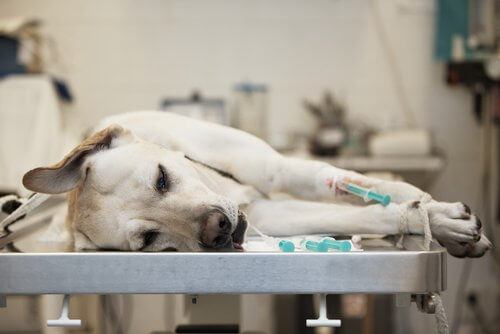Did You Know? Pets Can also Donate Blood!


Written and verified by the lawyer Francisco María García
Every day, different blood banks save the lives of many pets that require a blood transfusion. Today, pets who donate blood make it possible for blood transfusions be within the reach of many animals in need.
Pets who donate blood can save other dogs and cats
Urgent blood transfusions for dogs and cats are needed for different reasons: intoxication, anemia, accidents that cause a lot of blood loss, etc. If the veterinarian has access to blood for a transfusion, this will increase the chances of saving the life of the animal that needs it.
How do blood banks work?

A blood bank is a place where professionals store, process and preserve donated blood for later use in dogs, cats, and other pets.
Above all, it’s important that the quality of the stored blood is high, for this will have an impact on the health of the animals receiving it.
The blood used for transfusions must be of the same species and blood group as the receiving animal.
There are currently twenty-five animal blood banks in the US, both public and private. There are also some veterinary clinics and animal hospitals that have their donors and reserves and don’t need to go to a blood bank.
Animal blood banks in the US
There’s a good number of animal blood banks across the United States. In addition, many blood banks operate as nonprofit businesses, recruiting volunteer donor dogs in the community.
As examples of some private and public blood banks for dogs and cats, we have the following:
-
Animal Blood Bank DBA
-
Blue Ridge Veterinary Blood Bank
- Hemopet
-
The Veterinarians’ Blood Bank, Inc.
-
St. Louis Animal Blood Bank
-
Animal Blood Bank
-
The Pet Blood Bank
-
Sun States Animal Blood Bank
-
HemoSolutions
-
Rocky Mountain Blood Services
Which kinds of animals can donate blood?
Above all, pets who can qualify to donate blood are healthy dogs weighing more than 20kg and also cats in good health weighing 4 kilos or more.
Veterinarians also need to consider age as an important factor. The donor animal, dog or cat, shouldn’t be less than one year old or more than ten.

Doctors need to test the animal before the transfusion begins in order to make sure that they don’t carry any blood diseases. The donors will then be part of a database after the donating process ends. However, the donor pet’s owner won’t receive any financial compensation for this.
The process of donating blood for dogs or cats takes about half an hour. Ideally, the donor animal should be calm; if not, light sedation should be applied. They can give blood again after eight weeks.
About 450 ml of blood are taken from the dog when donating. How is this done? Well, it’s very easy. The animal is placed on a table, usually lying on one side, his hair removed in an area of his neck and a needle is inserted. This is where the blood will be extracted.
Some animals may feel weak after donating blood. However, most of them will show no reaction at all. Moreover, one donation alone could save up to two lives.
The donor animal will soon regenerate the extracted blood. Above all, it isn’t harmful to their health whatsoever.
Blood groups, blood donation between pets
Dogs have eight blood groups. Of these, one is considered universal, meaning it’s compatible with all the others. However, in the case of cats, there are only three different blood groups. As with people, a blood type test is a way of getting to know the animal’s blood group and thus perform transfusions.
For more information about animal blood banks in your area, call your local veterinarian, veterinary school or veterinary emergency clinic. They may have information about local blood banks and can guide you to them.
Every day, different blood banks save the lives of many pets that require a blood transfusion. Today, pets who donate blood make it possible for blood transfusions be within the reach of many animals in need.
Pets who donate blood can save other dogs and cats
Urgent blood transfusions for dogs and cats are needed for different reasons: intoxication, anemia, accidents that cause a lot of blood loss, etc. If the veterinarian has access to blood for a transfusion, this will increase the chances of saving the life of the animal that needs it.
How do blood banks work?

A blood bank is a place where professionals store, process and preserve donated blood for later use in dogs, cats, and other pets.
Above all, it’s important that the quality of the stored blood is high, for this will have an impact on the health of the animals receiving it.
The blood used for transfusions must be of the same species and blood group as the receiving animal.
There are currently twenty-five animal blood banks in the US, both public and private. There are also some veterinary clinics and animal hospitals that have their donors and reserves and don’t need to go to a blood bank.
Animal blood banks in the US
There’s a good number of animal blood banks across the United States. In addition, many blood banks operate as nonprofit businesses, recruiting volunteer donor dogs in the community.
As examples of some private and public blood banks for dogs and cats, we have the following:
-
Animal Blood Bank DBA
-
Blue Ridge Veterinary Blood Bank
- Hemopet
-
The Veterinarians’ Blood Bank, Inc.
-
St. Louis Animal Blood Bank
-
Animal Blood Bank
-
The Pet Blood Bank
-
Sun States Animal Blood Bank
-
HemoSolutions
-
Rocky Mountain Blood Services
Which kinds of animals can donate blood?
Above all, pets who can qualify to donate blood are healthy dogs weighing more than 20kg and also cats in good health weighing 4 kilos or more.
Veterinarians also need to consider age as an important factor. The donor animal, dog or cat, shouldn’t be less than one year old or more than ten.

Doctors need to test the animal before the transfusion begins in order to make sure that they don’t carry any blood diseases. The donors will then be part of a database after the donating process ends. However, the donor pet’s owner won’t receive any financial compensation for this.
The process of donating blood for dogs or cats takes about half an hour. Ideally, the donor animal should be calm; if not, light sedation should be applied. They can give blood again after eight weeks.
About 450 ml of blood are taken from the dog when donating. How is this done? Well, it’s very easy. The animal is placed on a table, usually lying on one side, his hair removed in an area of his neck and a needle is inserted. This is where the blood will be extracted.
Some animals may feel weak after donating blood. However, most of them will show no reaction at all. Moreover, one donation alone could save up to two lives.
The donor animal will soon regenerate the extracted blood. Above all, it isn’t harmful to their health whatsoever.
Blood groups, blood donation between pets
Dogs have eight blood groups. Of these, one is considered universal, meaning it’s compatible with all the others. However, in the case of cats, there are only three different blood groups. As with people, a blood type test is a way of getting to know the animal’s blood group and thus perform transfusions.
For more information about animal blood banks in your area, call your local veterinarian, veterinary school or veterinary emergency clinic. They may have information about local blood banks and can guide you to them.
This text is provided for informational purposes only and does not replace consultation with a professional. If in doubt, consult your specialist.








